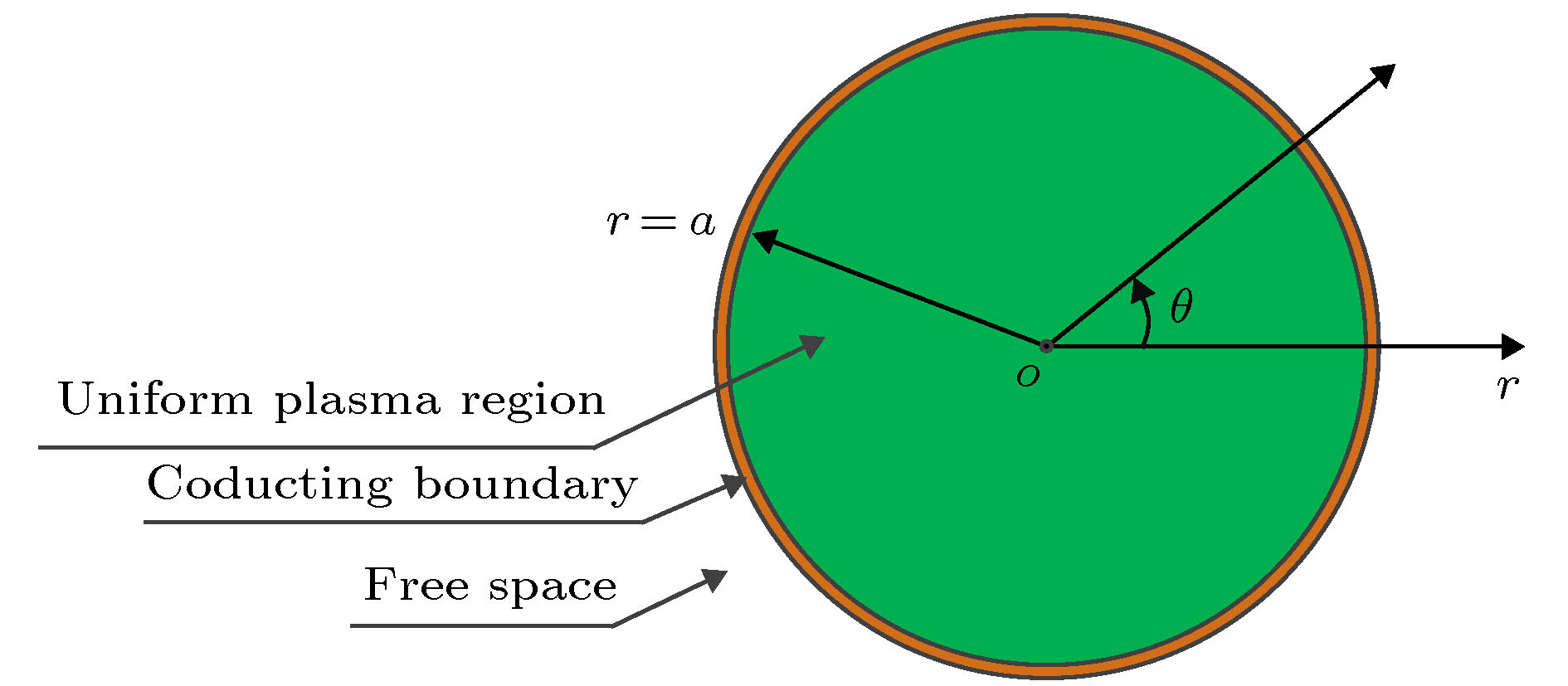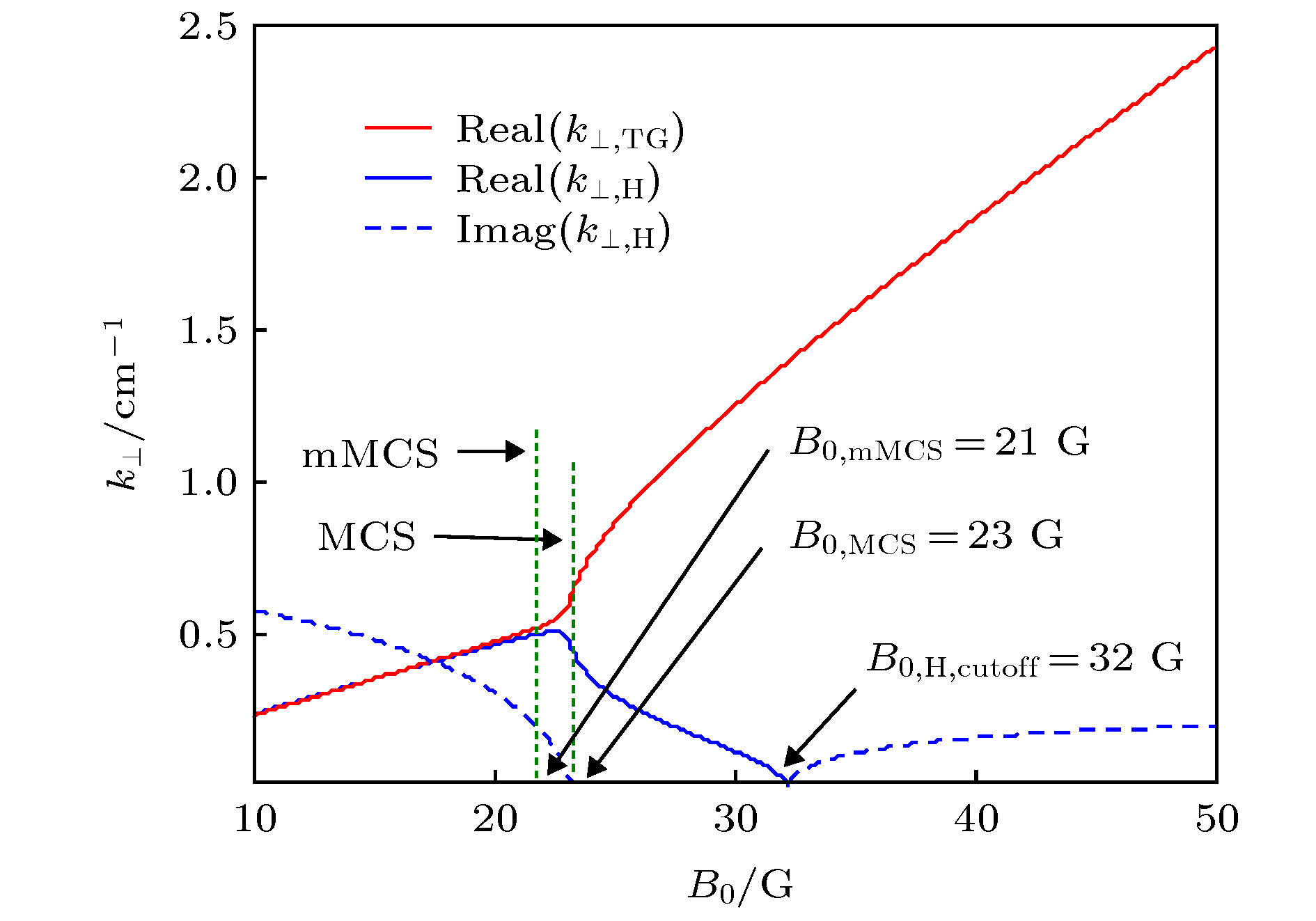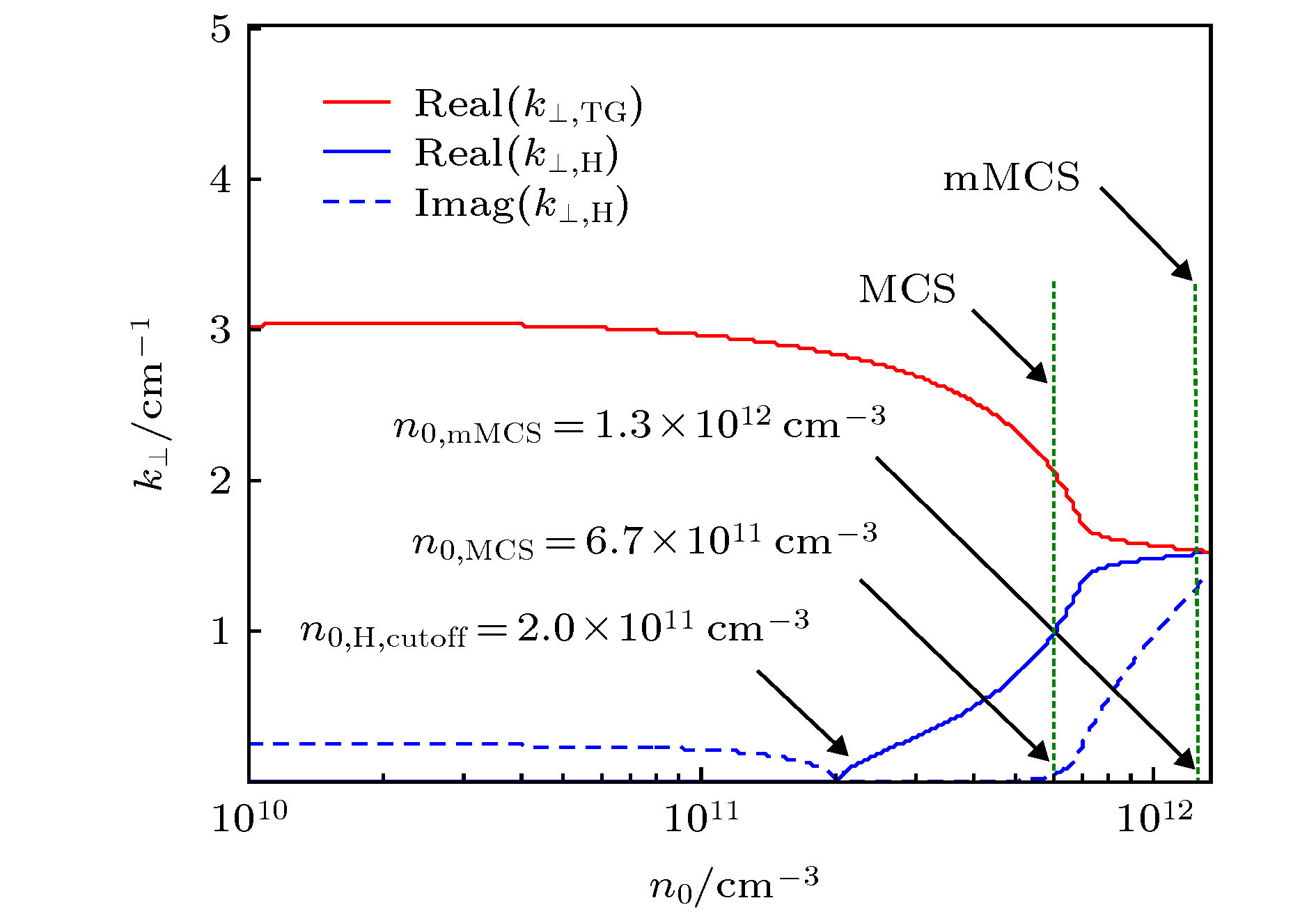-
采用有限温度等离子体介电张量模型, 在考虑粒子热效应情形下, 通过求解传导边界条件下等离子体柱中本征模的色散关系, 分析了螺旋波等离子体中典型参量条件下螺旋波与Trivelpiece-Gould (TG) 波的耦合特性及线性能量沉积特性. 在ω/(2π) = 13.56 MHz和TeV,i = 0.1TeV,e参量条件下计算结果表明: 对于螺旋波, 存在截止静磁场B0,H,cutoff与截止等离子体密度n0,H,cutoff, 在B0 > B0,H,cutoff或n0 < n0,H,cutoff条件下, 螺旋波变为消逝波; 在ω/ωce ∈ (0.01, 0.10)范围内, 对于m = 0 角向模, TG波Landau阻尼致使的能量沉积占主导地位, 而对于m = 1角向模, 螺旋波Landau阻尼或TG波Landau阻尼致使的能量沉积哪个占据主导地位则取决于B0的大小; 在ωpe/ωce ∈ (3, 100)范围内, TG波Landau阻尼致使的能量沉积占主导地位; 在整体能量沉积过程中, 对于m = 0模和m = 1模, Landau阻尼致使的能量沉积均占据主导地位.Based on the finite temperature plasma dielectric tensor model which contains the particle thermal effect, by numerically solving the eigenmode dispersion relation of electromagnetic waves propagating in radially uniform and magnetized warm plasma column which is surrounded by conducting boundary, the mode coupling characteristic and liner damping mechanism induced wave power deposition properties of helicon and Trivelpiece-Gould (TG) waves are parametrically analyzed. The detailed investigations show as follows. Under typical helicon plasma parameter conditions, i.e. wave frequency ω/(2π) = 13.56 MHz, ion temperature is much smaller than electron temperature, for the helicon wave, there exist a cut-off magnetic field B0,H,cutoff and a cut-off plasma density n0,H,cutoff, for which under the conditions of B0 > B0,H,cutoff or n0 < n0,H,cutoff, the helicon wave becomes an evanescent wave. When the magnetic field intensity changes from 48.4 to 484 G, i.e., ω/ωce ranges from 0.01 to 0.1, for the power deposition intensity, Landau damping of TG wave dominates for the m = 0 mode, meanwhile, for the m = 1 mode, which wave, i.e. helicon wave or TG wave, plays a major role in power deposition mainly depends on the magnitude of the magnetic field. On the other hand, for a given magnetic field B0 = 100 G, when ωpe/ωce changes from 3 to 100, for both the m = 0 mode and the m = 1 mode, the power deposition induced by Landau damping of TG wave plays a major role, further, one may notice that the power deposition of TG wave decreases while the power deposition of the helicon wave increases as plasma density increases. Finally, for both the m = 0 mode and the m = 1 mode, the power deposition due to the Landau damping plays a dominant role. All these conclusions provide us with some useful clues to better understanding the high ionization mechanism of helicon wave discharges.
-
Keywords:
- helicon plasma /
- mode coupling /
- power deposition /
- dispersion relation
[1] Chen F F 2015 Plasma Sources Sci. Technol. 24 014001
 Google Scholar
Google Scholar
[2] Isayama S, Shinohara S, Hada T 2018 Plasma Fusion Res. 13 1101014
 Google Scholar
Google Scholar
[3] Shinohara S 2018 Adv. Phys.: X 3 1420424
 Google Scholar
Google Scholar
[4] Aigrain P 1960 Proceedings of the International Conference on Semiconductor Physics Prague, Czech Republic, August 4–8, 1960 p224
[5] Chen F F 1991 Plasma Phys. Controlled Fusion 33 339
 Google Scholar
Google Scholar
[6] Shamrai K P, Taranov V B 1996 Plasma Sources Sci. Technol. 5 474
 Google Scholar
Google Scholar
[7] Shamrai K P, Taranov V B 1994 Plasma Phys. Controlled Fusion 36 1719
 Google Scholar
Google Scholar
[8] Shamrai K P 1998 Plasma Sources Sci. Technol. 7 499
 Google Scholar
Google Scholar
[9] Chen F F, Blackwell D D 1999 Phys. Rev. Lett. 82 2677
 Google Scholar
Google Scholar
[10] Blackwell D D, Chen F F 2001 Plasma Sources Sci. Technol. 10 226
 Google Scholar
Google Scholar
[11] Kline J, Scime E 2003 Phys. Plasmas 10 135
 Google Scholar
Google Scholar
[12] Kim S, Hwang Y 2008 Plasma Phys. Controlled Fusion 50 035007
 Google Scholar
Google Scholar
[13] Isayama S, Hada T, Shinohara S, et al. 2016 Phys. Plasmas 23 063513
 Google Scholar
Google Scholar
[14] 成玉国, 程谋森, 王墨戈等 2014 物理学报 63 035203
 Google Scholar
Google Scholar
Cheng Y G, Cheng M S, Wang M G, et al. 2014 Acta Phys. Sin. 63 035203
 Google Scholar
Google Scholar
[15] 平兰兰, 张新军, 杨桦等 2019 物理学报 68 205201
 Google Scholar
Google Scholar
Ping L L, Zhang X J, Yang H, et al. 2019 Acta Phys.Sin. 68 205201
 Google Scholar
Google Scholar
[16] Chen F F, Arnush D 1997 Phys. Plasmas 4 3411
 Google Scholar
Google Scholar
[17] Arnush D, Chen F F 1998 Phys. Plasmas 5 1239
 Google Scholar
Google Scholar
[18] Arnush D 2000 Phys. Plasmas 7 3042
 Google Scholar
Google Scholar
[19] Sakawa Y, Kunimatsu H, Kikuchi H, et al. 2003 Phys. Rev. Lett. 90 105001
 Google Scholar
Google Scholar
[20] Vey B 1984 PFC/RR-84-12 (Cambridge: Massachusetts Institute of Technology) pp30–31
[21] Niemi K, Krämer M 2008 Phys. Plasmas 15 073503
 Google Scholar
Google Scholar
[22] Shamrai K P, Shinohara S 2001 Phys. Plasmas 8 4659
 Google Scholar
Google Scholar
[23] Huba J D 2016 NRL Plasma Formulary (Washington: Naval Research Laboratory) p34
[24] Fried B D, Conte S D 2015 The Plasma Dispersion Function: the Hilbert Transform of the Gaussian (New York: Academic Press) pp1–3
[25] Mouzouris Y, Scharer J E 1998 Phys. Plasmas 5 4253
 Google Scholar
Google Scholar
[26] Shoji T, Sakawa Y, Nakazawa S, et al. 1993 Plasma Sources Sci. Technol. 2 5
 Google Scholar
Google Scholar
[27] Swanson D G 1989 Plasma Waves (New York: Academic Press) pp375–376
[28] Lafleur T, Charles C, Boswell R 2010 Phys. Plasmas 17 073508
 Google Scholar
Google Scholar
-
-
[1] Chen F F 2015 Plasma Sources Sci. Technol. 24 014001
 Google Scholar
Google Scholar
[2] Isayama S, Shinohara S, Hada T 2018 Plasma Fusion Res. 13 1101014
 Google Scholar
Google Scholar
[3] Shinohara S 2018 Adv. Phys.: X 3 1420424
 Google Scholar
Google Scholar
[4] Aigrain P 1960 Proceedings of the International Conference on Semiconductor Physics Prague, Czech Republic, August 4–8, 1960 p224
[5] Chen F F 1991 Plasma Phys. Controlled Fusion 33 339
 Google Scholar
Google Scholar
[6] Shamrai K P, Taranov V B 1996 Plasma Sources Sci. Technol. 5 474
 Google Scholar
Google Scholar
[7] Shamrai K P, Taranov V B 1994 Plasma Phys. Controlled Fusion 36 1719
 Google Scholar
Google Scholar
[8] Shamrai K P 1998 Plasma Sources Sci. Technol. 7 499
 Google Scholar
Google Scholar
[9] Chen F F, Blackwell D D 1999 Phys. Rev. Lett. 82 2677
 Google Scholar
Google Scholar
[10] Blackwell D D, Chen F F 2001 Plasma Sources Sci. Technol. 10 226
 Google Scholar
Google Scholar
[11] Kline J, Scime E 2003 Phys. Plasmas 10 135
 Google Scholar
Google Scholar
[12] Kim S, Hwang Y 2008 Plasma Phys. Controlled Fusion 50 035007
 Google Scholar
Google Scholar
[13] Isayama S, Hada T, Shinohara S, et al. 2016 Phys. Plasmas 23 063513
 Google Scholar
Google Scholar
[14] 成玉国, 程谋森, 王墨戈等 2014 物理学报 63 035203
 Google Scholar
Google Scholar
Cheng Y G, Cheng M S, Wang M G, et al. 2014 Acta Phys. Sin. 63 035203
 Google Scholar
Google Scholar
[15] 平兰兰, 张新军, 杨桦等 2019 物理学报 68 205201
 Google Scholar
Google Scholar
Ping L L, Zhang X J, Yang H, et al. 2019 Acta Phys.Sin. 68 205201
 Google Scholar
Google Scholar
[16] Chen F F, Arnush D 1997 Phys. Plasmas 4 3411
 Google Scholar
Google Scholar
[17] Arnush D, Chen F F 1998 Phys. Plasmas 5 1239
 Google Scholar
Google Scholar
[18] Arnush D 2000 Phys. Plasmas 7 3042
 Google Scholar
Google Scholar
[19] Sakawa Y, Kunimatsu H, Kikuchi H, et al. 2003 Phys. Rev. Lett. 90 105001
 Google Scholar
Google Scholar
[20] Vey B 1984 PFC/RR-84-12 (Cambridge: Massachusetts Institute of Technology) pp30–31
[21] Niemi K, Krämer M 2008 Phys. Plasmas 15 073503
 Google Scholar
Google Scholar
[22] Shamrai K P, Shinohara S 2001 Phys. Plasmas 8 4659
 Google Scholar
Google Scholar
[23] Huba J D 2016 NRL Plasma Formulary (Washington: Naval Research Laboratory) p34
[24] Fried B D, Conte S D 2015 The Plasma Dispersion Function: the Hilbert Transform of the Gaussian (New York: Academic Press) pp1–3
[25] Mouzouris Y, Scharer J E 1998 Phys. Plasmas 5 4253
 Google Scholar
Google Scholar
[26] Shoji T, Sakawa Y, Nakazawa S, et al. 1993 Plasma Sources Sci. Technol. 2 5
 Google Scholar
Google Scholar
[27] Swanson D G 1989 Plasma Waves (New York: Academic Press) pp375–376
[28] Lafleur T, Charles C, Boswell R 2010 Phys. Plasmas 17 073508
 Google Scholar
Google Scholar
计量
- 文章访问数: 13760
- PDF下载量: 114
- 被引次数: 0














 下载:
下载:









